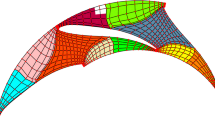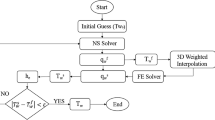Abstract
Prediction of the clearance between the components of a rotor and casing of a gas turbine is generally based on the two-dimensional (2D) finite-element analysis of the overall layout, the three-dimensional (3D) finite-element analysis of the local parts, and the deformation of the gas turbine components caused by other, unimportant 3D effects, such as cold-build clearances and ovalization. Using this, the variation of clearance, the minimum clearance, and the contact evaluation between the components with respect to the operation time are evaluated. Detailed 3D modeling of the overall shape for transient thermal-structural analysis for the prediction of clearances between components under the operating conditions of gas turbines with complex components, including both axisymmetric and non-axisymmetric shapes, is not economical in terms of computational time and cost. To address this problem, it is efficient to perform finite-element analysis by means of 2D modeling based on the crosssectional information of the gas turbine components. At this moment, the 2D finite-element modeling for the axisymmetric and non-axisymmetric structures of the gas turbine is important for predicting the correct and accurate deformation. In this paper, we show that 2D modeling can obtain results similar to those of 3D finite-element analysis for the original shape. The proposed 2D finite-element modeling method for rotor and support of a gas turbine that includes both axisymmetric and non-axisymmetric shapes will enable rapid and effective prediction of the components' behavior.
Similar content being viewed by others
References
R. Kumar, V. S. Kumar, M. M. Butt, N. A. Sheikh, S. A. Khan and A. Afzal, Thermo-mechanical analysis and estimation of turbine blade tip clearance of a small gas turbine engine under transient operating conditions, Applied Thermal Engineering, 179 (2020) 115700.
E. A. Davis, A Study of a Combined 2D Axisymmetric and 3D Cyclically Symmetric Finite Element Model of a Turbine Disk, RPI Mater's Project, Rensselaer Polytechnic Institute, Hartford, Connecticut (2008).
K. E. Leach, Accounting for the Stiffness of Three-Dimensional Features in a Two-Dimensional Axisymmetric Rotating Disk Analysis, RPI Mater's Project, Rensselaer Polytechnic Institute, Hartford, Connecticut (2012).
P. Vaishaly and B. S. V. Ramarao, Finite element stress analysis of a typical steam turbine blade, International Journal of Science and Research, 4 (7) (2015) 1059–1065.
L. Bozzi, A. Perrone and L. Giacobone, Procedure for calculation of component thermal loads for running clearances of heavy-duty gas turbines, Proceedings of ASME Turbo Expo, 4 (GT2012-68184) (2012) 1863–1875.
L. Bordo, S. Bruzzone, A. Perrone and L. Traversone, Prediction of clearance in industrial gas turbine validated by field operation data, Proceedings of ASME Turbo Expo, 7 (GT2012- 69617) (2012) 675–683.
L. K. Park and I. G. Kim, Development of steam turbine finite element modeling method and validation, Proceeding of the KSME 2015 Annual Meeting (2015) 1369–1373.
A. Elhefny and G. Liang, Stress and deformation of rocket gas turbine disc under different loads using finite element modelling, Propulsion and Power Research, 2 (1) (2013) 38–49.
F. Vivio and V. Vullo, Elastic stress analysis of rotating converging conical disks subjected to thermal load and having variable density along the radius, International Journal of Solids and Structures, 44 (24) (2007) 7767–7784.
V. Vullo and F. Vivio, Elastic stress analysis of non-linear variable thickness rotating disks subjected to thermal load and having variable density along the radius, International Journal of Solids and Structures, 45 (20) (2008) 5337–5355.
J. S. Im, S. J. Heo, K. R. Chung, G. B. Lee and Y. M. Yoo, Thermal stress analysis for life prediction of power plant turbine rotor, Trans. Korean Soc. Mech. Eng., 14 (2) (1990) 288–297.
S. Moaveni, Finite Element Analysis: Theory and Application with ANSYS, 4th Edition, Pearson (2015).
ANSYS, Inc., ANSYS Mechanical APDL Theory Reference, Release 2020 R1, Canonsburg, USA (2020).
H. W. Seo, K. K. Kim and J. S. Han, Prediction of clearance between gas turbine components through finite element analysis, Proceedings of the 2017 COSEIK Annual Conference (2017) 35.
Acknowledgments
This work was supported by a Research Grant of Andong National University, Korea.
Author information
Authors and Affiliations
Corresponding author
Additional information
Jeong Sam Han received his B.S. degree in Mechanical Engineering from Kyungpook National University, Korea, in 1995. He then went on to receive his M.S. and Ph.D. degrees from KAIST, Korea, in 1997 and 2003, respectively. Dr. Han is currently a Professor at the Department of Mechanical & Robotics Engineering at Andong National University, Korea. His research interests include the areas of model order reduction, CAEbased deep learning, structural optimization, and rotordynamics for industry applications, etc.
Rights and permissions
About this article
Cite this article
Seo, H.W., Han, J.S. 2D finite-element modeling of 3D blade structures with axisymmetric and non-axisymmetric shapes. J Mech Sci Technol 34, 5177–5184 (2020). https://doi.org/10.1007/s12206-020-1119-y
Received:
Revised:
Accepted:
Published:
Issue Date:
DOI: https://doi.org/10.1007/s12206-020-1119-y




